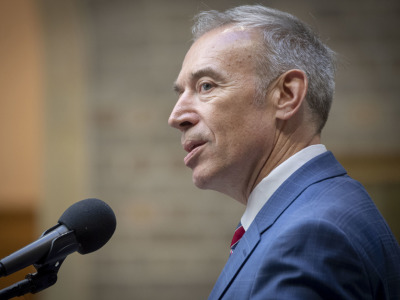Jake Robinson’s first USDA trade mission changed his export promotion strategy, and his most recent one only reinforced that belief.
USDA Trade Undersecretary Alexis Taylor led last week’s trade mission to Chile and was joined by numerous state ag leaders, commodity groups and 14 private sector businesses. Robinson, the chief development officer for Minnesota-based Red Lake Inc., said the Chilean mission — which also focused on export opportunities to Peru and Ecuador — was his fourth such business trip.
“For us, they're an excellent opportunity to introduce product to new markets, learn about potential markets, and have exposure to export sales that we normally wouldn't have through our organic business activities,” he told Agri-Pulse on the sidelines of the Espacio Food and Service trade show, where trip participants were showcasing products and meeting with potential business partners.
Red Lake sells cultivated wild rice and some value-added products like rice flour and gluten-free pancake mixes. Robinson said countries that already incorporate rice frequently into their familiar cuisine have proven to be valuable markets, with consumers who might be interested in exploring a new twist on a familiar staple.
In his previous export promotion exercises, Robinson would hold court in a trade show booth, hoping the display might attract some new business. But on the latest mission, Robinson and several others took part in one-on-one meetings that offered a much more targeted approach.
“Having vetted buyer meetings has been an excellent resource,” he said, noting USDA staff and other in-country contractors “find businesses that fit our category.” The trips have also included a market briefing that offers participants a forum to learn more about the market and “really discern where the best opportunity is for us, whether that be in retail, food service, (or) working directly with an importer or wholesaler,” Robinson added.
Red Lake has been in the bulk rice export business for more than three decades, but Robinson said the company was previously “heavily concentrated in a few different markets that have become recently very volatile.” In his effort to diversify the company’s overseas markets, Robinson has been able to turn recent trade missions into business, including through products exported to East Africa, pending shipments to the Netherlands, and promising connections in Japan.
 Jake Robinson, Red Lake, Inc.Robinson noted the company partners with the Intertribal Agriculture Council — a recipient of more than $360,000 in Market Access Program funding in the 2023 fiscal year — to help defray the costs of promotional activities. Roughly half the company’s food and agriculture business is in exported wild rice, and Robinson believes growing MAP funding in the farm bill would only improve the company’s current exports.
Jake Robinson, Red Lake, Inc.Robinson noted the company partners with the Intertribal Agriculture Council — a recipient of more than $360,000 in Market Access Program funding in the 2023 fiscal year — to help defray the costs of promotional activities. Roughly half the company’s food and agriculture business is in exported wild rice, and Robinson believes growing MAP funding in the farm bill would only improve the company’s current exports.
“It would really allow us to allocate more resources, more time and more personnel to developing export markets,” he said. “As we kind of start to build out our export footprint, it's obviously going to take more bandwidth, and being able to attend more events and have staff specifically for servicing these accounts and these market developments would be huge.”
Robinson was far from alone. Many other participants in last week’s trip were there as a result of MAP funding. The Southern U.S. Trade Association, a recipient of $5.3 million in MAP funding in FY 23, was helping many companies with their Espacio exhibits. Another participant, Beverly Flaten with JM Grain in North Dakota, has taken part in several other trade missions through a partnership with the Food Export Association of the Midwest, which received more than $10.6 million in MAP funding in FY 23.
Flaten attributed about 40% of the export sales for JM Grain, which sells chickpeas and lentils to overseas buyers, to contacts made on USDA trade missions. She’s even seen her company’s bags in foreign retail markets, where customers could scoop out their desired quantity.
“When you see that (bag) made it across the ocean, and it’s going onto somebody's table … they're taking it home and they're making their lentil soup that night, it's pretty incredible.,” she told Agri-Pulse.
It’s easy to be “in the know” about what’s happening in Washington, D.C. Sign up for a FREE month of Agri-Pulse news! Simply click here.
Many farm groups have prioritized the doubling of funding for MAP and the Foreign Market Development program in the upcoming farm bill. Among them is the American Soybean Association, which passes along the majority of its MAP funding to the U.S. Soybean Export Council.
ASA CEO Steve Censky says despite repeated warnings from congressional leaders about the tight budget environment facing the upcoming farm bill, he believes Ag Committee leadership on Capitol Hill “hasn’t given up” on generating new resources for the bill, which would be necessary for the MAP and FMD funding expansion.
What’s more, USDA’s response to a request from Senate Ag Chair Debbie Stabenow, D-Mich., and ranking member John Boozman, R-Ark., is set to funnel another $2.5 billion into the broader effort of trade promotion, as Agri-Pulse has previously reported. Censky said while the details of the package are still undetermined, it will likely be a short-term fix.
 ASA CEO Steve Censky
ASA CEO Steve Censky“It doesn't solve the underlying problem that you need to increase the mandatory funding levels for those programs. And so for the next five years, you might be OK and you would get that top-up and that boost of funding,” Censky said. “But come the next farm bill you still are at the same $237 million of MAP and FMD combined where we are right now.”
Robinson said Red Lake is “very supportive” of a funding increase and has encouraged Minnesota’s two senators — Ag Committee Democrats Amy Klobuchar and Tina Smith — to take up the issue as well.
Taylor, the USDA undersecretary who led the Chilean mission, acknowledged in a conversation for Agri-Pulse Newsmakers that MAP and FMD are — at current funding levels — both “highly leveraged programs with federal government and industry dollars, and they see a really high rate of return.
“I think it is why Congress is having such an important conversation as they discuss farm bill funding is because people see the benefit that these programs and these dollars really do in supporting U.S. businesses expanding their agricultural export picture,” she said.
For more news, go to www.Agri-Pulse.com.


